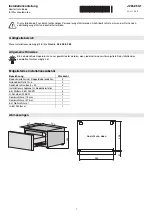
Function Reference
BTSC Sound
5
5-55
Select among:
1. Single tone mode
Stereo ON, L = 0.3 kHz, 1 kHz, or 3 kHz, R = 0
2. Double tone mode
Stereo ON, for example, L = 3 kHz, R = 1 kHz
3. Double tone mode (L = 300 Hz, R = 3.1 kHz) using Test 1,
which is especially useful for Philips BTSC Decoder circuit TDA 9855 but may be
useful also for other decoders.
•
SAP level adjustment of BTSC decoders.
To adapt the SAP output level of a BTSC decoder to the corresponding level of the
Mono signal (volume), Test 3 generates L+R and SAP with 100%.
•
Further performance measurements concerning harmonic distortion, frequency
response, and bandwidth are possible.
Recommendations
Because the BTSC receiver is sensitive to the signal level and to interfering frequency
components, there are several sources of decreasing performance. Any of the following
can cause loss in stereo channel separation.
•
Bandwidth reduction within the IF or intercarrier filters of receivers or excessive
group delay ripple.
•
Frequency response of FM demodulators.
•
Interfering components from the video modulation, mainly n x fH.
To reduce problems during alignments or measurements of BTSC sound, it is recom-
mended that you turn off the video modulation of the 54200 with BTSC sound (Video
Extern mode).
For stereo separation alignments, it is also helpful to select a stereo signal with a lower
and a higher frequency component. As long as the stereo signals are high enough this
leads to a masking of interfering components.
For example:
L = 3 kHz and R = 1 kHz, or Test 1, or Test 2.
Summary of Contents for 54200
Page 2: ......
Page 6: ......
Page 14: ......
Page 20: ...54200 Users Manual 1 4...
Page 28: ...54200 Users Manual 1 12...
Page 32: ...54200 Users Manual 1 16...
Page 44: ...54200 Users Manual 1 28...
Page 45: ...2 1 Chapter 2 Main Features Title Page Introduction 2 3 Main Features 2 3...
Page 46: ......
Page 50: ......
Page 142: ...54200 Users Manual 4 76...
Page 153: ...Function Reference TELETEXT 5 5 11 Figure 5 5 Position and Level of Antiope Data Lines...
Page 266: ...54200 Users Manual 6 58...
Page 292: ...54200 Users Manual 8 2...
Page 322: ...54200 Users Manual 8 32...
Page 324: ......
Page 325: ...A 1 Appendix A TV Systems Used in Various Countries...
Page 326: ...54200 Users Manual A 2...
Page 334: ......
Page 335: ...B 1 Appendix B VHF UHF Channel Frequencies for Different TV Systems...
Page 336: ...54200 Users Manual B 2...
Page 345: ...C 1 Appendix C Default Settings for Countries...
Page 346: ...54200 Users Manual C 2...
Page 348: ......
Page 349: ...D 1 Appendix D Spectras of TV Audio Systems...
Page 350: ...54200 Users Manual D 2...
Page 351: ...Spectras of TV Audio Systems Examples D D 3 Examples...
Page 352: ......
Page 353: ...E 1 Appendix E Nomenclature of Color Bar Signals...
Page 354: ...54200 Users Manual E 2...
Page 356: ......
Page 357: ...F 1 Appendix F Menu Trees...
Page 358: ......
Page 359: ...Menu Trees F F 3...
Page 360: ...54200 Users Manual F 4...
Page 361: ...Menu Trees F F 5...
Page 362: ...54200 Users Manual F 6...
Page 363: ...Menu Trees F F 7...
Page 364: ...54200 Users Manual F 8...
Page 365: ...G 1 Appendix G Pattern Popup Menus...
Page 366: ...G 2...
Page 372: ...54200 Users Manual G 8...
Page 378: ...54200 Users Manual 6...
Page 380: ...54200 54100 Users Manual Manual Supplement 1...
















































